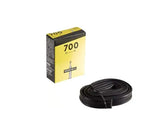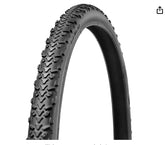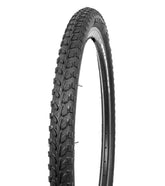Filter
33 results
15
- 10
- 15
- 20
- 25
- 30
- 50
Best selling
- Featured
- Best selling
- Alphabetically, A-Z
- Alphabetically, Z-A
- Price, low to high
- Price, high to low
- Date, old to new
- Date, new to old
Sort
Sort by:
- Featured
- Best selling
- Alphabetically, A-Z
- Alphabetically, Z-A
- Price, low to high
- Price, high to low
- Date, old to new
- Date, new to old
-
Ralson Himalayan Trial Bicycle Tyre – 27.5 & 29 Inch Upgrade your ride with the Ralson Nylon 1pc, one of the finest bicycle tyres designed for city bicycles, mountain bikes, and hybrid bicycles in India. Suitable for 27.5-inch and 29-inch wheels, this tyre for...
- Rs. 899.00
- Rs. 899.00
- Unit price
- / per
-
Ralson 26*2.10 Nylon Bicycle Tyre – Premium Performance for All Terrains Upgrade your ride with the Ralson 26*2.10 Nylon — a high-quality option in bicycle tyres designed for 26-inch wheels. Perfect for city, mountain, and hybrid bikes, this tyre for bicycle offers exceptional grip,...
- Rs. 599.00
- Rs. 599.00
- Unit price
- / per
-
Bicycle Tyre Nylon 1pc Best Quality Bicycle Tires Spare Part for City Bicycle , Mountain Bike and Hybrid Bicycles in India for 26/27.5/29 Inch wheel at Best online Price. These Quality tyres Combining exceptional rolling speed and excellent corning stability to achieve the highest...
- Rs. 799.00
- Rs. 799.00
- Unit price
- / per
-
Upgrade your ride with the Bicycle Tyre 26*1.95 Ralson Nylon 1pc, engineered for performance, durability, and versatility. Designed to fit 26-inch wheels, this high-quality tyre for bicycle is perfect for city bikes, mountain bikes, and hybrid bicycles in India. Crafted with a premium nylon...
- Rs. 699.00
- Rs. 699.00
- Unit price
- / per
-
Ralson 29*2.1 Nylon MTB Bicycle Tyre – Superior Traction for Mountain Adventures Conquer every trail with the Ralson 29*2.1 Nylon MTB — a premium choice in bicycle tyres built for mountain biking. Designed for stability, control, and durability, this tyre for bicycle delivers outstanding...
- Rs. 800.00
- Rs. 800.00
- Unit price
- / per
-
Ralson Enduro Nylon Bicycle Tyre – Premium Performance for All Terrains Upgrade your ride with the Ralson Nylon Bicycle Tyre, designed to deliver unmatched performance for city, mountain, and hybrid bikes. Suitable for 26-inch, 27.5-inch, and 29-inch wheels, this premium spare part is crafted...
- Rs. 999.00
- Rs. 999.00
- Unit price
- / per
-
Bicycle Tyre 29*2.40 Ralson Nylon 1pc 29X2.40 (1 PC) Best Quality Bicycle Tires Spare Part for City Bicycle , Mountain Bike and Hybrid Bicycles in India for 29 Inch wheel at Best online Price. These Quality tyres Combining exceptional rolling speed and excellent corning...
- Rs. 999.00
- Rs. 999.00
- Unit price
- / per
-
Bicycle Inner Tube 26T with 32mm Schrader Valve (1 Piece) Bicycle Inner tube for 26 Inch, 29 Inch and 700C Bicycle tire with the same tire dimensions. Be sure to verify the valve type and length also. Bicycle Inner tube for 26 Inch Technical...
- Rs. 387.00
- Rs. 387.00
- Unit price
- / per
-
Ralson Vector Bicycle Tyre – Premium Performance for 27.5 & 29 Inch Wheels The Ralson Nylon 1pc is a top-tier choice in bicycle tyres, designed for city bicycles, mountain bikes, and hybrid bicycles in India. Compatible with 27.5-inch and 29-inch wheels, this tyre for...
- Rs. 899.00
- Rs. 899.00
- Unit price
- / per
-
Ralson Explorer Macro MTB Bicycle Tyre – 27.5 & 29 Inch High-Performance Ride The Ralson Nylon 1pc is crafted for riders who demand durability, control, and speed. Designed for city bicycles, mountain bikes, and hybrid bicycles in India, this premium option in bicycle tyres...
- Rs. 899.00
- Rs. 899.00
- Unit price
- / per
-
Bicycle Inner Tube 29T with 32mm Schrader Valve (1 Piece) 29X2.10 Bicycle Inner tube for 29 Inch Technical Specification for Bicycle Tube 1 Piece Inner Tube Brand Name - Ralson ISO 622 x 35-40 32mm Schrader Valve Replacement inner tube for a hybrid, fitness,...
- Rs. 415.00
- Rs. 415.00
- Unit price
- / per
-
Brand Generic Material Butyl Rubber Bike Type Road Bike, Mountain Bike, BMX Bike Manufacturer Schrodinger Size 25 inches About this item Schrodinger 40075 Bicycle Cycle Tube 700 x 23/32 Presta Valve The Generic Bicycle Tube by Schrodinger is built for cyclists who demand...
- Rs. 799.00
Rs. 999.00- Rs. 799.00
- Unit price
- / per
-
Brand Ralson Tire Type Tubeless Bike Type Mountain Bike Material Nylon Size 700 * 35c About this item Ralson Rock On 700x35C Hybrid Bicycle Tyre – Smooth & Reliable Urban Performance The Ralson Rock On 700x35C is designed for riders who demand comfort, control,...
- Rs. 699.00
Rs. 1,613.00- Rs. 699.00
- Unit price
- / per
-
Brand shaqraa Tire Type Tubular Item Width 5 Centimetres Bike Type Road Bike, Mountain Bike Material Rubber About this item Bedrock Fighter 26x2.125 Bicycle Tyre – Built for All-Terrain Performance Experience unmatched riding confidence with the Bedrock Fighter 26x2.125 inch – one of the...
- Rs. 599.00
Rs. 750.00- Rs. 599.00
- Unit price
- / per
-
Brand Ralson Tire Type Mountain Bike Nylon Tyre Bike Type Mountain Bike Material Nylon Tread Type Knobby About this item Ralson Mountain Bike Nylon Tyre – Built for Tough Trails Conquer challenging terrains with the Ralson Mountain Bike Nylon Tyre, engineered for riders who...
- Rs. 700.00
- Rs. 700.00
- Unit price
- / per

















